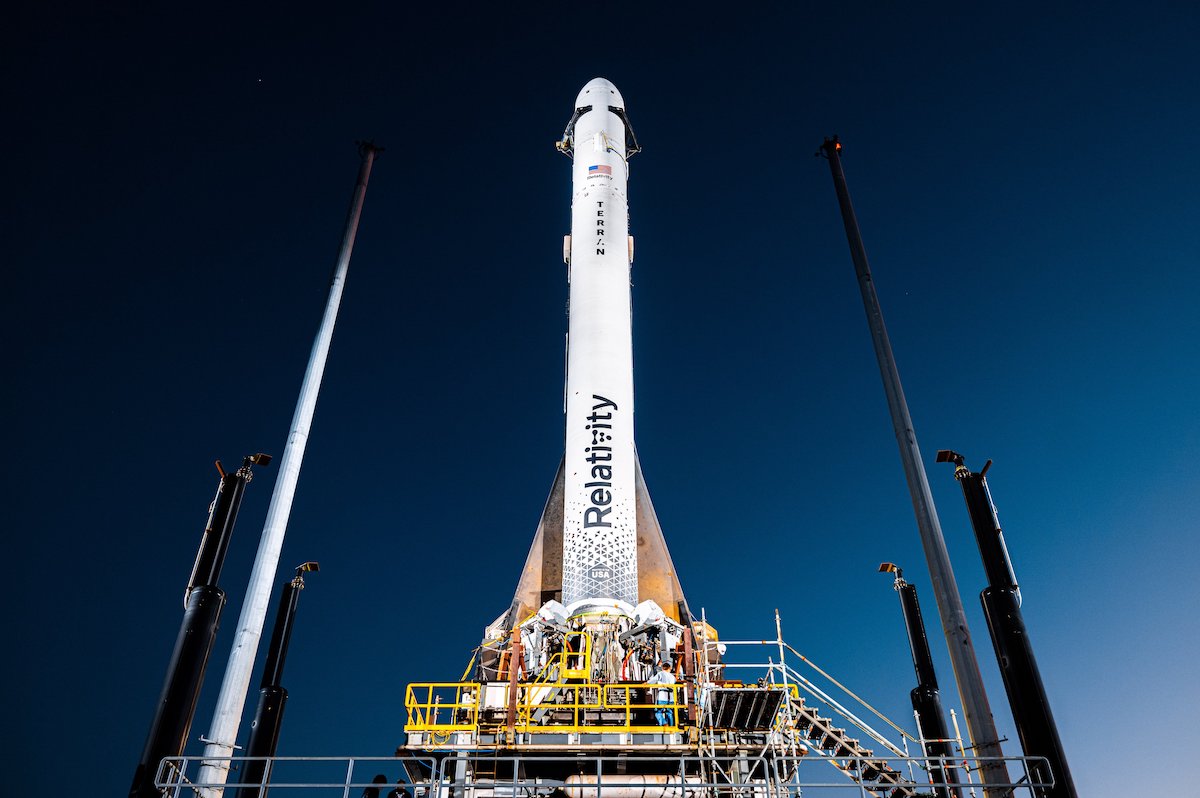
Relativity Space plans to skip a final test-firing of its first fully stacked Terran 1 rocket at Cape Canaveral and proceed with a launch attempt March 8 for the methane-fueled, 3D-printed launcher, the company said Wednesday.
The first Terran 1 rocket will take off from Launch Complex 16 at Cape Canaveral Space Force Station, where Relativity engineers and technicians have run the launch vehicle through tests to ensure it is ready for flight. The rocket arrived at Cape Canaveral last June after Relativity built the two-stage vehicle and its engines in California.
Relativity has a three-hour launch window reserved with the U.S. Space Force’s Eastern Range on March 8. The launch window opens at 1 p.m. EST (1800 GMT). The company said Wednesday it has received a launch license from the Federal Aviation Administration, the regulatory agency overseeing commercial space launches.
The tests on the launch pad have included multiple fueling demonstrations and test-firings of the Terran 1 first stage, culminating in an 88-second hold-down firing on the launch pad in October. Relativity returned the Terran 1 booster to a nearby hangar and attached it with the rocket’s second stage, with plans to perform a test-firing of the fully integrated launch vehicle before moving forward with a launch attempt.
But a company spokesperson said Wednesday teams will proceed with a launch attempt without completing the final static fire test of the full 110-foot-tall (33.5-meter) rocket. The company believes the tests already performed on the Terran 1 rocket are enough to move forward with a launch countdown, the spokesperson said.
Without performing the final hold-down test-firing, Relativity accepts an increased chance of an abort on the first launch attempt. The spokesperson said the company is trying to balance the risk of wear and tear on the Terran 1 rocket from continued testing with the risk of proceeding with the test flight.
Computers check the health of all launch vehicle systems, including engines, before giving the command to release the rocket for flight. If there’s a problem, the countdown will abort and the engines will shut down on the pad. If all systems are working normally, hold-down restraints will release to allow the Terran 1 to climb off the launch pad and climb into orbit.
About 85% of the 20,458-pound (9,280-kilogram) structural mass of the Terran 1 rocket is manufactured with 3D printing technology, including its Aeon engines, fed by methane fuel and super-cold liquid oxygen. 3D printing allows Relativity to manufacture rockets with 100 times fewer parts than launch vehicles built using conventional methods, the company says.
“We are on the launch pad almost ready to go with the world’s first 3D printed rocket,” tweeted Tim Ellis, Relativity’s co-founder and CEO. “It’s been a truly wild ride to get to this point, and certainly way harder than I ever imagined going into it — but all the feels from me and our team as we embark on this historic launch. There is a very bright future ahead for Relativity Space!”
The nine Aeon 1 engines on the first stage of the Terran 1 rocket will generate about 207,000 pounds of thrust at full power.
A company spokesperson said Relativity has completed six ignitions and more than 185 seconds of Hotwire time for all nine Aeon 1 engines on the first stage of the Terran 1 rocket, with no ignition failures, premature engine shutdowns, or engine swaps. The engines and the Terran 1’s autogenous pressurization system, which uses self-generated gases to maintain pressure in the propellant tanks, have performed well during the ground tests, Relativity said.
Overall, Relativity has completed 191 Aeon 1 hotfire tests with 10,900 seconds of run time during engine qualification and acceptance testing on a firing stand at NASA’s Stennis Space Center in Mississippi.
The second stage of the Terran 1 rocket, powered by a single “Aeon Vac” engine optimized for firings in space, completed a full “mission duty cycle” simulating the burn it will perform on the test flight. Relativity also completed structural loads testing on the first and second stages of the Terran 1 rocket, and functional testing on stage separation and other “flight-critical” mechanisms.

The expendable Terran 1 rocket can carry up to 2,755 pounds, or 1,250 kilograms, of cargo to a low-altitude orbit. That’s significantly more than other commercial small satellite launchers, such as Rocket Lab’s Electron vehicle. Relativity says it sells a dedicated launch on a Terran 1 rocket for $12 million.
The first Terran 1 test flight will not carry a customer payload. It’s purely a test flight, which Relativity has nicknamed “Good Luck, Have Fun.”
Headquartered in Long Beach, California, Relativity Space is also developing a larger reusable rocket called Terran R, designed to haul more than 20 metric tons of cargo to low Earth orbit. Like the Terran 1, the larger Terran R will take off from Launch Complex 16 at Cape Canaveral.
The Terran R will be powered by a larger engine Relativity is developing called the Aeon R.
Email the author.
Follow Stephen Clark on Twitter: @StephenClark1.
